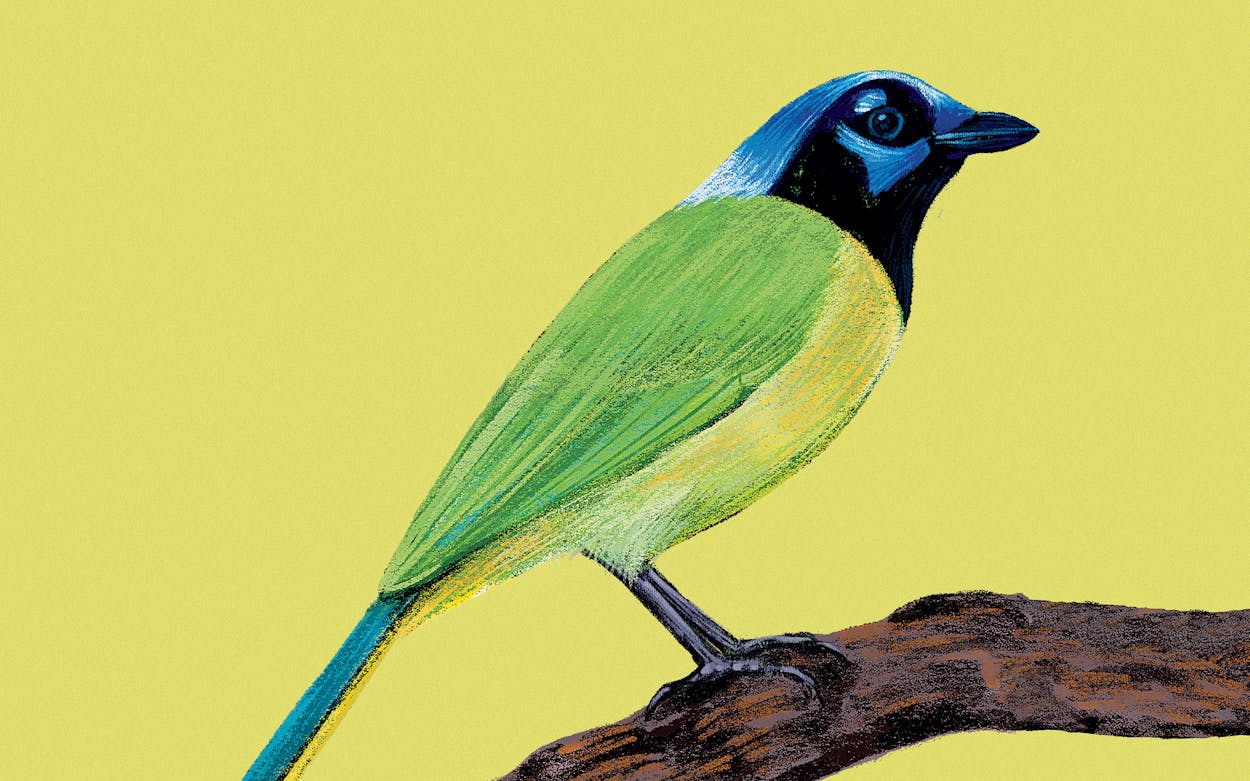Imagine a blue jay who comes back from a Cancún resort with a jaunty new wardrobe. That’s the green jay, one of the most colorful birds in Texas. Its dramatic blue-and-black face evokes a lucha libre wrestler’s mask, while the bright yellow belly, lime-green back, and teal tail feathers are straight from a watercolor palette. This is one of the charismatic fliers that make the Lower Rio Grande Valley a global birding destination, especially in the winter. More than five hundred species, or 45 percent of all those found in the U.S., have been seen in the region.
Where else does it live?
The green jay is common along the coasts of Mexico and Central America, and a closely related subspecies, the Inca jay, flits around South America. But in the U.S., the highly intelligent, nonmigratory corvid was found only in far South Texas—until recently.
Until recently, you say?
That’s right. Though the Lower Rio Grande Valley remains the best place to spot this coveted creature, the green jay is taking wing across a growing swath of South Texas. Within the past year, folks on eBird, an online database, have posted sightings in Corpus Christi, Uvalde, and Medina. “A lot of species with broad habitat preferences are moving north, taking advantage of milder winters,” says Timothy Brush, an ornithologist and professor emeritus at the University of Texas Rio Grande Valley. While the Audubon Society warns that 64 percent of North American species could go extinct if the planet continues warming at its current pace, there may be one (literal) bright spot for Texans: we just might see more colorful, warm-weather species making their way across our state.
Why are tropical birds so bright anyway?
No one knows for sure, but scientists have some guesses: these birds eat fruits rich in organic pigments; they have ample energy to invest in evolving eye-catching displays to attract a mate; and the tropics are home to a higher number of species, so it helps to stand out. This past summer, Brian Stokes, a UT–Austin graduate student, caught what could be the first known wild hybrid of a blue jay and a green jay, in San Antonio.
You mentioned that this jay is highly intelligent?
It’s part of the corvid family, which also includes crows, ravens, magpies, and the like; all tend to be unusually brainy. Corvids have been shown to recognize human faces, solve tricky puzzles, and even understand analogies. They can also use tools: the green jay sometimes grabs a twig to pry up loose bark and get at the tasty insects underneath. It also practices communal nesting, an endearing behavior in which the adolescent birds stay close to their parents for about a year to help guard the nest of their younger siblings. When a predator approaches, the teens will sound the alarm or chase the intruder away. “They’re quite smart, and I think they have pretty individual personalities,” says Stokes. “They sometimes outsmart me when I’m doing fieldwork.”
What does it eat besides insects?
It’s not picky. The green jay eats all manner of bugs, seeds, nuts, and fruit; it’s even been known to chow down on the occasional lizard or small snake. If you live in its range and want to attract it to your yard, try putting out some fresh orange slices or corn cobs. Those might just prove to be irresistible.
This article originally appeared in the January 2024 issue of Texas Monthly with the headline “Green Jay.” Subscribe today.
- More About:
- Critters
- South Texas









